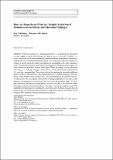Por favor, use este identificador para citar o enlazar a este item:
http://hdl.handle.net/10261/170804COMPARTIR / EXPORTAR:
 SHARE SHARE
 CORE
BASE CORE
BASE
|
|
| Visualizar otros formatos: MARC | Dublin Core | RDF | ORE | MODS | METS | DIDL | DATACITE | |

| Título: | How Au Outperforms Pt in the Catalytic Reduction of Methane Towards Ethane and Molecular Hydrogen |
Autor: | Martínez, José I. CSIC ORCID ; Calle-Vallejo, Federico; Andrés, Pedro L. de CSIC ORCID CVN | Palabras clave: | Nanoparticle catalyst Methane reduction Ethane evolution Hydrogen production Density functional theory Phonons Thermodynamics Transition-state |
Fecha de publicación: | ago-2018 | Editor: | Springer Nature | Citación: | Topics in Catalysis 61(12-13): 1290-1299 (2018) | Resumen: | Within the context of a “hydrogen economy”, it is paramount to guarantee a stable supply of molecular hydrogen to devices such as fuel cells. Besides, catalytic conversion of the environmentally harmful methane into ethane, which has a significantly lower Global Warming Potential, is an important endeavour. Herein we propose a novel proof-of-concept mechanism to accomplish both tasks simultaneously. We provide transition-state barriers and reaction Helmholtz free energies obtained from first-principles Density Functional Theory by taking account vibrations for 2CH4(g)→C2H6(g)+H2(g) to show that H2 can be produced by subnanometer Pt38 and Au38 nanoparticles. The active sites for the reaction are located on different planes on the two nanoparticles, thus differentiating the working principle of the two metals. The complete cycle to reduce CH4 can be performed on Au and Pt with similar efficiencies, but Au requires only half the working temperature of Pt. This sizable decrease of temperature can be traced back to several intermediate steps, in excellent agreement with previous experiments, but most crucially to the final one where the catalyst must be cleaned from H(⋆) to be able to restart the catalytic cycle. This highlights the importance of including in catalytic models the final cleaning steps. In addition, this case study provides guidelines to capitalize on finite-size effects for the design of new and more efficient nanoparticle catalysts. | Versión del editor: | http://doi.org/10.1007/s11244-018-0992-4 | URI: | http://hdl.handle.net/10261/170804 | DOI: | 10.1007/s11244-018-0992-4 | ISSN: | 1022-5528 | E-ISSN: | 1572-9028 |
| Aparece en las colecciones: | (ICMM) Artículos |
Ficheros en este ítem:
| Fichero | Descripción | Tamaño | Formato | |
|---|---|---|---|---|
| MatinezTiC2017.pdf | 9,12 MB | Adobe PDF |  Visualizar/Abrir |
CORE Recommender
Page view(s)
329
checked on 24-abr-2024
Download(s)
921
checked on 24-abr-2024
Google ScholarTM
Check
Altmetric
Altmetric
NOTA: Los ítems de Digital.CSIC están protegidos por copyright, con todos los derechos reservados, a menos que se indique lo contrario.
